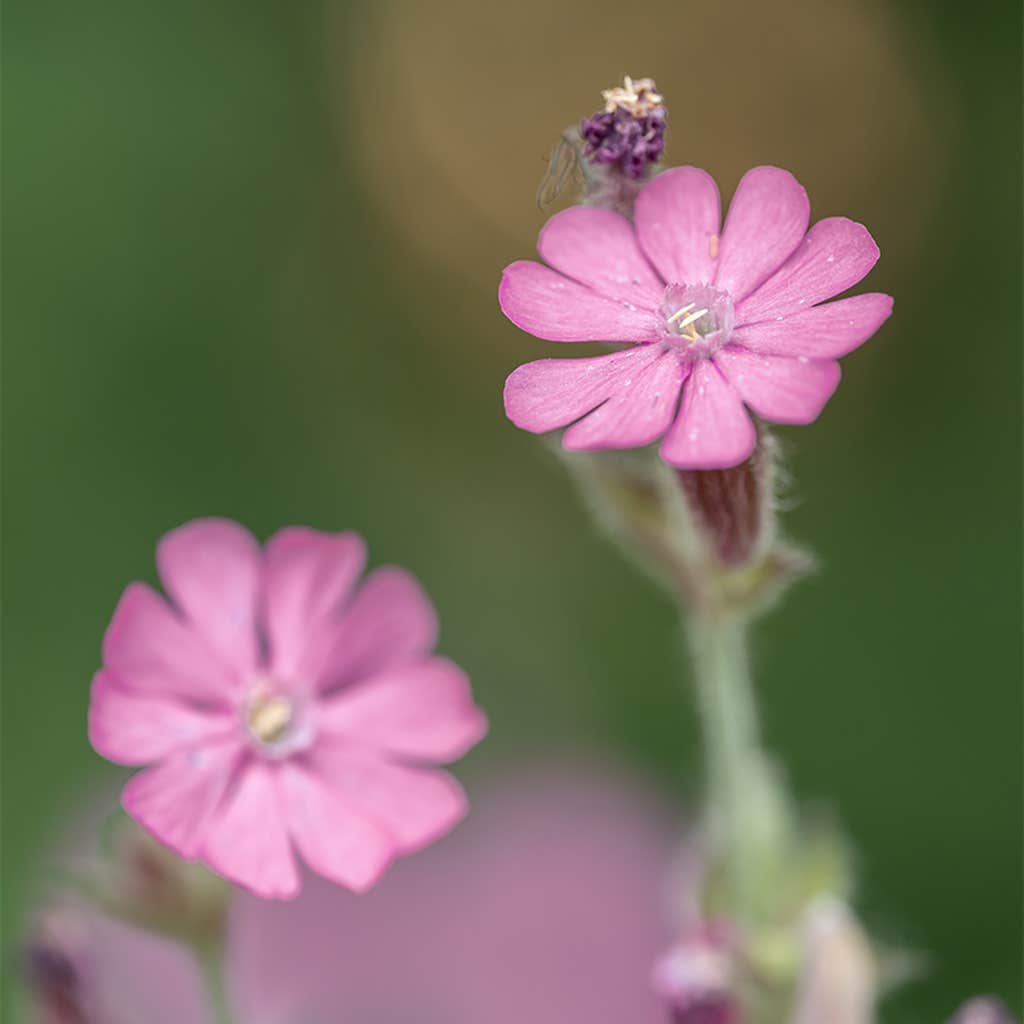Lydia Becker sat down at her desk in the British village of Altham, a view of fields unfurling outside of her window. Surrounded by her notes and papers, the 36-year-old carefully wrote a short letter to the most eminent and controversial scientist of the day, Charles Darwin.
It was May 18, 1863, and on a thin piece of paper, she humbly presented herself in a clear sloping hand and enclosed local flowers she had been examining, Lychnis dioica. These were not just any country lane blossoms, their vivid magenta petals common enough. With her keen eye, Becker had noticed something unusual about their reproductive bits that would challenge the very conception of the sexes in botany—and beyond.
Down in London, Charles Darwin, inundated with letters, may have nearly missed the missive, but he did open it. It was not the first time he had been sent botanical samples by a stranger, but in this note, three unexpected words jumped out at him: “unique … bisexual flowers.”
The idea blurred the strict male-female binary system accepted by Victorian society—and horrified critics.
Darwin scarcely had time to examine them before Becker headed back out into the wooded grasslands near to her house. She wished to gather and share more botanical samples, feeling that her first letter perhaps didn’t make her point sufficiently. To this end, Becker boxed up a small package of further evidence in the form of samples of this curious plant, its seeds, and pollen—and described to Darwin in detail her wild idea that this plant could transcend reproductive norms. It could fill the roles previously prescribed separately to male and female individuals. Becker was more confident in this second letter, sent just three days after her first, sure now that she had observed botanical sexual variations that were both unique and would be of use to Darwin.
She was right.
Prevailing scientific theory at the time maintained that plants had been created as intended by God—and that plant reproduction echoed other sex patterns established in the Bible: There were male and female plants, which together could create new life. Darwin was challenging these ideas. His 1859 On the Origin of Species had, just four years prior, suggested that all plants had evolved from four or five progenitors and that the evolution of reproduction within plants had occurred incrementally as resources and tasks had evolved—being shared by both sexes.
When Becker wrote to him, Darwin’s botanical studies were focusing in on the nature of plant reproduction, and he was in the process of gathering samples from all over the British Isles. His findings were leading him to argue that plants had evolved in the same manner as animals—and that their reproductive system and evolution was much more complex than the simple binary gender system that had been promoted since the 1730s through the widely accepted Linnaean categories.

Darwin argued that, unlike Adam and Eve, plants were not subject to strict male and female roles. Instead, he suggested, their reproduction was driven by natural selection mechanisms which promoted cross-pollination and that within individual plants, the male and female sexual systems could in fact be combined or merged. This idea dared to blur the strict male-female binary system accepted by Victorian society—which horrified his critics, who attacked him for flagrant immorality. Critics such as theologian John Leifchild accused him of “excluding (the) Deity from acts of creation” and implying that Adam and Eve were no more than fictional characters in a story.
Today, we know that most plants are, in fact, hermaphrodites, able to self-fertilize, and can reproduce sexually, asexually, or by both methods when necessary. (Although most plants seem to avoid self-fertilizing if possible, to avoid the dangers of genetic inbreeding.) Only 5 percent of all plants, it turns out, have fully separate sexes. Hermaphrodites benefit from being able to self-fertilize, and thus survive when no suitable mating partner is available. Darwin was just beginning to grasp this when he was trying to untangle the evidence and work out why botanical hermaphroditism would ever be inferior to the established idea of fully separate sexes.
Enter Becker, who joined a growing legion of scientists who read Darwin’s work and were flocking to this provocative revolution. In keeping with convention for privileged young women, Becker had been educated at home, with the exception of a few months spent at boarding school. Early on, she was fascinated by the sciences, especially botany and astronomy, interests in which an uncle—though not her parents—enthusiastically encouraged her. As she got older, she grew increasingly frustrated by the restrictions contemporary society placed upon her life and her intellectual development as a woman.
Three words jumped out at Darwin:
“unique … bisexual flowers.”
Chafing against the expectations of her to assume the métiers of wife and mother, Becker instead turned her attention to developing her own intellect (particularly in studying the science behind the sexes) and helping other women do the same. To this end, she founded the benign-sounding Manchester Ladies Literary Society in 1865. Social book club, it was not. It was a serious scientific organization through which women studied and shared their research and findings. Becker passionately believed that, “It is better that maids, old and young, should graduate in the School for Science rather than in the School for Scandal.”
And from this position she never wavered. Becker never married, preferring to believe in a more natural and—to contemporary Victorian eyes—radical alternative and sexual social order in which women were not inferior and subject to men.
Becker continued to live in her family home with her relatives and study the flora in and around the countryside surrounding Manchester, walking the parks frequently, scanning the ground for the unusual or perfect specimen, which she would carry carefully home to examine more closely. Becker kept up with the most current literature in the discipline. A steady stream of publications on the science of more exotic plant specimens, sent by other scientists and those which Becker ordered, fell through her letter box with a frequency which raised the eyebrows of her family.
By 1863, Becker felt confident enough to publish what she termed her “own little book” called Botany for Novices. In what appeared to be an unassuming overview, she set out basic botanical principles, featured her favorite plants—“I love the English Yew with its thousand years of gloom!”—and daringly discussed her growing interest in plant sexuality and hermaphroditism.
It was this interest that led Becker to approach Darwin. She had observed that some plants did not follow the sex-defined roles that she saw enforced on humans by British society. If plants could deviate from these presumed patterns, could people? Perhaps she could use her observations of sexes in the natural world to argue for gender equality in the socially constructed one.

In her first letters to Darwin, Becker asserted that she had found male, female, and hermaphrodite specimens of the Lychnis flowers around Manchester. She proposed that the hermaphroditism was an adaptation to its Manchester environment, maybe as a result of the increased urbanization or the harsher climate. Darwin had similar thoughts at the time, and Becker’s observations supported his ideas about situational botanical reproductive adaptations. Darwin wanted to see if he could replicate what she had found. He sowed the seeds Becker had sent him. He followed her methodology in order to, “try, as you have done, next year to fertilize the little ovaria.” He would later refer to Becker’s observations in his own published works on the subject.
Encouraged by Darwin’s interest, Becker sent him a copy of her own book. In return, he sent her a copy of his own papers “Two forms in species of Linum,” which detailed his view on flax’s reciprocal sexual relationships and hermaphroditic forms.
Soon letters between Darwin and Becker were winding their way back and forth, up and down the Great North Road. Between 1863 and 1869 Becker’s letters become more informal and bolder; she tells him that her Manchester Ladies “society appears likely to prosper beyond my expectations” and that she transcribed his letters without permission—but feels sure he will not object.
Powered by the success of her scientific society, by 1866 Becker turned her attention to what she felt were more pressing matters. She wrote once again to Darwin, this time telling him that she “had not been able to pursue my study of the Lychnis flowers nor my endeavour to penetrate the mystery of their variation of form, for since then we have ceased to reside in the country and now [I am] surrounded by acres of bricks and mortar.” The family had moved into burgeoning, urban Manchester. This move away from the flora-filled lanes and fields, however, gave Becker the opportunity to share her knowledge with those among whom she now lived. Manchester was then a hotspot of social foment, where the issues of women’s rights, racial equality, and workers unions all were bubbling away. And she formed a new group in its midst, which proved wildly popular.
Eager to provide for the group worthy educational material, not just material deemed suitable for women, she wrote to Darwin and asked him to send her a paper for her to read aloud at the first meeting of her new society. Darwin dutifully sent her the requested papers.
Whether or not he knew he was writing to a feminist society is unclear, but the fact that Becker wrote to him on paper clearly headed “The Manchester National Society for Women’s Suffrage” made her position quite clear. Becker’s scientific studies had by now helped to bolster her view that there should be equality between the sexes, and that although the sexes had differences in the natural world, there was no evidence that one form was superior to the other.
Her research on the roles of the sexes came to the attention of Manchester’s Medical Officer for Health, who used her work as the basis of his argument for equal access to healthcare between the sexes in the new health system the city was founding. Becker was soon taking to the meeting halls of Manchester and giving talks on such contentious subjects as the role and legal position of wives, the right of women to education, and the right of women to vote. She toured the north of England, lecturing on scientific and feminist topics. In November 1867, she escorted Lily Maxwell to the polling station in Manchester to cast the first parliamentary vote by a woman in the United Kingdom since women had been disenfranchised 35 years earlier.
Becker continued her scientific studies, asking the advice of Darwin on various botanical matters until 1870. In her last surviving letter to Darwin, she offers her own position regarding his theory of Pangenesis—one of Darwin’s later (and eventually disproven) theories about heredity in which he suggested that cells were cast off around the body and accumulated in the sex organs for reproduction. In her letter, she clearly has reasons for doubts about this idea—and expects Darwin himself will be interested in hearing them.
Most of Darwin’s responses to Becker have been lost. But it’s possible he, too, eventually came around to the idea that, as Becker concluded, if no plant sex was superior to the other, then surely the idea that, as she wrote, “man has superiority or headship over woman [is] the root of all social evils.” ![]()
Lead image: Olga Korneeva / Shutterstock





















